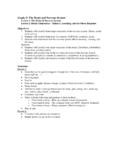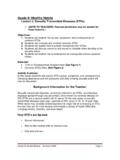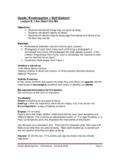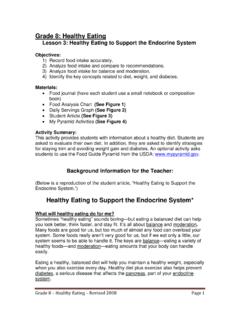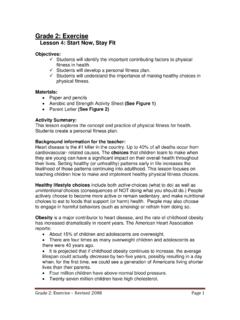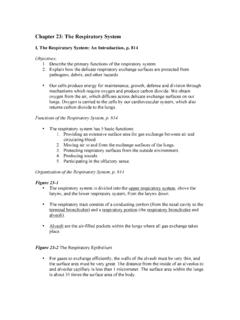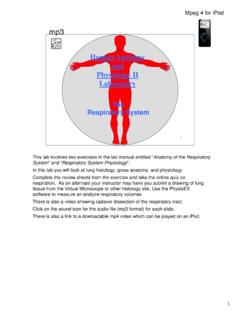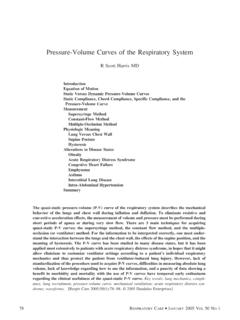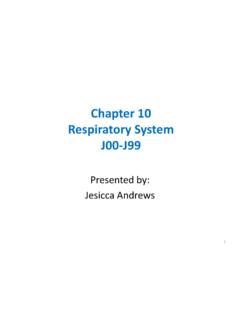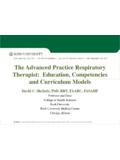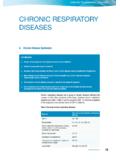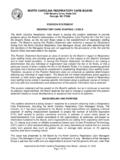Transcription of Grade 7: The Respiratory System and Lungs Lesson 1: The ...
1 Grade 7: The Respiratory System and Lungs Lesson 1: The Lungs and Respiratory System Lesson 2: Breathing Lesson 3: Respiratory Problems Objectives: 1. Students will describe the parts of the Respiratory System . 2. Students will explain the function of the Lungs , diaphragm, trachea, bronchia, and alveoli. 3. Students will explain the three stages of the breathing process and what occurs in each stage. 4. Students will explain two major risk factors for five Respiratory problems. 5. Students will explain two ways to protect themselves against five Respiratory problems. 6. Students will explain the connection of the Respiratory System to four other body systems. Materials: Lesson 1: Quiz (See Figure 1). Body Outline (See Figure 2). Respiratory anatomy charts Body organ model Materials to build Lungs (examples: sponge, balloons, liter soda bottles, water bottles, straws, tubes, string, clay, etc.)
2 Lesson 2: few drops of red cabbage juice in a cup of water a funnel a hair dryer a straw a beaker water marker tub milk jug and lid plastic tub Lesson 3: Understanding Respiratory Problems (See Figure 3). Activity Summary: In this Lesson students will explore the parts and functions of the Respiratory System , the connection of the Respiratory System with other body systems, the three stages of the breathing process and five Respiratory problems. Students will expand their study to compare and contrast the human Respiratory System with the Respiratory systems of animals, plants, and the Earth's ecosystem. Grade 7: The Respiratory System and Lungs Revised 2008 Page 1 Background Information for the Teacher: Overview Breathing is an amazing body activity and is a common factor in physical, mental, and emotional activity and health. Breathing is an essential part of what we think of as the mind/body/spirit connection.
3 It is not an exaggeration to say that breath is the significant link that makes the mind/body/spirit connection real. We use breath to sustain and energize our life, to calm our emotions, and to settle our minds. Whenever a person's breathing changes-- becoming slower or faster (OR shorter or longer), the body, mind, and emotions respond accordingly. Physiologically, breathing is an activity of the Respiratory System and it is actively connected to many other body systems. Breathing and its benefits are not an isolated activity involving only the Lungs . The Respiratory System is connected to the heart and circulatory System through the cardio-pulmonary circulatory process that accomplishes the gas exchange required to keep oxygen and carbon dioxide in balance. Oxygen is carried in the blood, traveling everywhere throughout the body. The nervous System is involved with the breath and is affected by the breath as well.
4 The autonomic nervous System engages the sympathetic and parasympathetic divisions to activate and calm breathing rhythms associated with the stress response. The Respiratory activity of transporting oxygen around the body connects to the digestive System , supplying energy for digestion. Oxygen in the blood goes to the muscular System , providing energy to burn the food nutrients needed for muscle movement. Parts of the Respiratory System The Respiratory System consists of more than just the Lungs . These are the major parts of the Respiratory System : Nasal cavity The passage for air entering and leaving the Lungs . Cilia The lining of the nasal cavity. These are tiny hair-like structures that trap the small particles of dust and foreign matter that don't belong in the Lungs . This is a very important function that helps keep our Lungs clean and clear, allowing us to breathe efficiently.
5 Mouth A passageway for air as well as food into the body. Pharynx Located in the throat, this is the passageway for food into the esophagus. Grade 7: The Respiratory System and Lungs Revised 2008 Page 2 Esophagus Food moves through the pharynx into the esophagus, which is the passageway for food into the stomach. Epiglottis Acting as a trapdoor to the trachea, it keeps food from entering the trachea and blocking the airway. Trachea Branching off from the esophagus, this is the passageway for air to the Lungs , often called the windpipe. Bronchia branches off from the trachea, with one branch going to each lung Alveoli Attaches and branches off the bronchioles throughout the Lungs . The oxygen/carbon dioxide exchange happens in these tiny air sacs. There are about 300 million alveoli in the Lungs . This extraordinary number of alveoli provides a gas contact area of about 60 sq meters, or the area of a room 24 x 24 feet, roughly the size of a tennis court.
6 Lungs In these two large organs the oxygen/carbon dioxide exchange occurs. The left lung is slightly smaller than the right as the heart intrudes into the left lung area a bit. The left lung has two lobes, while the right one has three. The Lungs are large, taking up most of the chest or thoracic cavity, and are soft, spongy, expandable, and light. Each one weighs about a pound (454 grams) and contains about 30,000 bronchioles in each lung. Bronchioles are only as thick as a single strand of the finest hair, each ending in a group of bubble-like air sacs called alveoli. There are about 350 million alveoli in each lung. Pleura Airtight sacs surrounding each lung. Diaphragm Because the Lungs are not capable of any movement on their own, they are entirely dependent upon the surrounding musculature called the diaphragm. A large dome-shaped muscle below the Lungs , the diaphragm is the primary muscle of respiration.
7 When we are breathing properly this muscle is doing most of the work, not the muscles of our neck, shoulders, and chest. The diaphragm separates the chest cavity from the abdominal cavity, making a kind of floor for the chest cavity. This muscle covers the entire bottom area inside the ribcage from the spine (and the ribs attaching to the spine) wrapping all the way around to the front of the ribcage to the bottom of the sternum (breastbone). In the front we can feel the movement of the diaphragm. If we place our fingers on the bottom edge of the rib portion directly under the nipple and Grade 7: The Respiratory System and Lungs Revised 2008 Page 3 angle the fingertips in towards the middle of the body, we will feel the diaphragm as it contracts into the abdominal organs. The small muscles between each rib also contract, lifting and expanding the bony ribcage. These are the secondary muscles of respiration.
8 When we take a deep breath it is easy to feel this thoracic expansion. Taking a Breath and Letting It Go The breathing process occurs automatically. Our breath adjusts to our needs without us having to do anything consciously. At the same time, though, it is a body function over which we can exercise a lot of control--speeding it up or slowing it down instantaneously and at will. There is virtually no other body System , other than the skeletal muscles, about which we can make that same claim. The Respiratory and circulatory systems are a powerful team where two significant body organs--the heart and the Lungs --work together. They ensure that the body is served with sufficient amounts of oxygen-rich blood as well as providing the return and removal of carbon dioxide waste products from our System . The Three Stages of the Breath: 1. Inhaling Oxygen (Air) INTO the Body: The diaphragm expands into the abdominal cavity, where the intestines are located.
9 Other muscles cause the ribs to move up and out, creating room in the chest (thoracic cavity). The Lungs expand with the air that has entered through the nose and mouth. Inhalation (or inspiration) is the active breathing phase. 2. Gas Exchange in the Lungs : Air enters the Lungs through the bronchial tube that branches into bronchioles which branch into alveoli. The alveoli are surrounded by the capillaries of the pulmonary arteries and veins. Oxygen from the inflated Lungs moves from the alveoli into the capillaries as carbon dioxide moves from the capillaries into the alveoli. 3. Exhaling Carbon Dioxide (Air) OUT of the Body: The diaphragm muscle relaxes and returns to its dome-like position inside the ribcage. The ribcage muscles also relax. This pressure surrounding the Lungs pushes air out of the body. Carbon dioxide is released from the body by traveling through the alveoli to the bronchiole to the bronchi, up the trachea and out through the nose and mouth.
10 Exhalation (or expiration). is the passive phase of breathing. Grade 7: The Respiratory System and Lungs Revised 2008 Page 4 Care of our Respiratory System We can consistently make choices and take actions that help keep our Respiratory System strong: 1. CHOOSE to surround yourself with healthy air. This means not to smoke and not hanging out with friends when they are smoking. Choosing to stay smoke-free is one of the best all- around health decisions we can EVER make. Stay out of areas that have polluted air. Choose not to sniff inhalants. They are so hazardous to lung health that in extreme cases they can suck all the oxygen out of the Lungs , causing the inhalant to suffocate. This is known as Sudden Sniffing Death. 2. Drinking lots of water, getting plenty of rest, and eating wisely and well are three things that help us keep our immune System healthy and strong. When our immune System is run down, we are more susceptible to getting the colds and illnesses that surround us.
